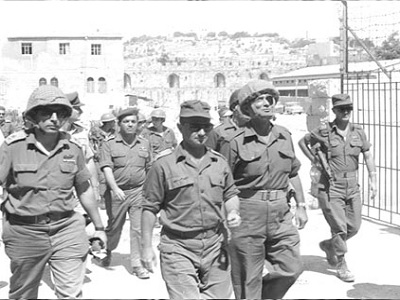
Israel has released new documents dating from the 1967 war. According to Hebrew newspaper Yedioth Ahronoth the papers date from the period during and immediately after the war and “document Israeli officials’ discussions regarding the fate of the occupied Arab territories.”
In one of the documents Zerah Verheftig, a minister, suggested distinguishing between Sinai and Golan on the one hand, and the West Bank on the other. He said, “Sinai’s regions and Golan Heights are considered to be occupied by Israel, while the West Bank has been liberated.”
Moreover, Defense Minister Moshe Dayan said during a government debate in December 26, 1967, “I do not think that the Arabs will agree and accept the borders that were formed after the war.” He went on, “Egypt will in no way accept Israel’s permanent presence in the East bank of the Suez Canal.”
Prisoners
On October 1, 1967, the Israeli Government discussed the idea of exchanging prisoners with Egypt. Minister Yigal Allon proposed a prisoner exchange, “Egypt is detaining our security officers, those who have been professionally trained in Israel, have taken military grades and were sent there to work. It is true that they failed, but they are not responsible for that,” in reference to the Israeli intelligence’s attempt to blow up offices of US and British interests in Egypt in the 1950s, and the arrest of their agents in Egypt.
New doc on 1967 war "includes accounts of Israelis summarily executing prisoners and evacuating Arab villages" http://t.co/aLJIfiHJwr
— Peter Hart (@peterfhart) January 26, 2015
Minister Pinchas Sapir responded, “Egypt does not care about the five thousand Egyptian prisoners that were held by Israel. Therefore, Israel does not consider these prisoners as useful leverage.”
Dayan also said that he rejected the idea of abusing Egyptian prisoners for the sake of Israel’s reputation, “When the Egyptian prisoner is under my hand and unable to do anything, I would not harm him. I do not want the world to put Israel on the list of countries that mistreat prisoners.”
In another discussion, which was held on December 27, 1967, a proposal was made to liberate part of the Egyptian prisoners as a sign of goodwill. During the discussion, Dayan said that “the detainees’ families will not agree and want their sons in exchange for the Egyptians who will be released.”
#Zionists army takin #Palestinian civilian prisoners in 1967 war and immediately executed them #USA #UN #UK #HUMANITY pic.twitter.com/HMlCyb4K
— Zaid زيـد (@ZaidAtalla) July 8, 2012
The newspaper added, “The Israeli government has finally agreed on the proposal to free one or two Egyptian generals and to send them to Cairo to convince its president, Gamal Abdel Nasser, to conclude a prisoner exchange deal with Israel. At the end, it was decided to free 500 Egyptian prisoners, including generals, in order to persuade the Egyptians to release the detained Israelis they have.”
The Sinking of the Israeli Destroyer, Eilat
“Many of the documents also said the Egyptians targeted the destroyer Eilat and caused it to sink.” – Yedioth
On October 21, 1967, Egypt attacked the destroyer with missiles when it was sailing in the Port Said area, killing 47 men of the naval staff and injuring 91 others. An event that has become an important crossroads in the history of Israel in general and its army and navy in particular.
The newspaper continued: “The day after the destroyer’s sinking, a government session was held in the office of Defense Minister Dayan. There was a hard and tense atmosphere and there was a desire and a to retaliate against Egyptians, but there was a need to find the right time and place for that.”
On October 21, 1967, 50 years ago, two Egyptian Soviet-built boats (project 183R) with missiles P-15 sank the Israeli destroyer "Eilat" pic.twitter.com/s1SI7ZJfAK
— Hammer Head (@KitadicaCool) October 21, 2017
Military Leader, Haim Bar-Lev said: “We can by no means overlook Egypt’s targeting of the destroyer. We must counterattack.”
Dayan described the matter as “a catastrophe that struck dozens of Israeli families. We have also lost a destroyer. It is also a catastrophe for us, but I do not have a weapon that can defeat the missiles that targeted the destroyer. Whenever Egyptians fire these missiles, they would always have the upper hand.”
According to the documents, Yitzhak Rabin, then Chief of Staff, rejected the possibility of targeting the Egyptian navy: “Egyptian submarines and destroyers are in Yemen, and we cannot reach that place.”
21st October 1967: Israel's destroyer Eilat, the biggest INS, was sunk by 2 Egyptian missile boats, 91 injured & 47 killed. #Egypt – #Israel pic.twitter.com/9B0lfxjHwJ
— Bassem El-Telawy (@BTelawy) October 21, 2016
He suggested attacking Egyptian refineries with artillery shelling, and refused attacking old navy vessels in Port Said or attacking Alexandria again, in light of the Egyptian high state of alert there.”
Menachem Begin, who was a minister of the same government at that time, said: “Port Said must be punished and must get a taste of an Israeli attack. It is the city from which the missiles that sank the destroyer Eilat were launched.”
On October 24, 1967, three days after the destroyer’s sinking, the Israeli army shelled the refineries and fertilizer factories in the city of Suez with artillery.
(MEMO, PC, Social Media)






The missile commentary should hold significance for those looking at U.S. naval power and its attempts to control the oceans near China.